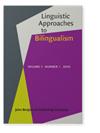L2 acquisition of the Chinese plural marker -men by English and Korean speakers
IF 1.8
2区 文学
0 LANGUAGE & LINGUISTICS
引用次数: 0
Abstract
This article investigates the L2 acquisition of the Chinese plural maker -men by English and Korean speakers within the framework of the Feature Reassembly Hypothesis (FRH) (Lardiere, 2009). The Chinese plural suffix -men, the Korean plural suffix -tul, and the English plural suffix -s share some properties and differ on others. Thirty-two English-speaking learners and thirty-five Korean-speaking learners of Chinese of advanced and intermediate proficiency were tested using a truth value judgment task and a grammaticality judgment task. Results show that: (i) all the L2 groups have acquired the target feature set of -men (i.e., [plural, specific, human]); (ii) the two English groups and the advanced Korean group but not the intermediate Korean group have acquired the conditions on the overt realization of -men (i.e., optionality with demonstratives and prohibition with classifiers). The results are consistent with the FRH: differences in how features are assembled in lexical items and differences in conditions on feature realization between the L1 and L2 lead to acquisition difficulty; such difficulty can be overcome, though native-like performance is not guaranteed.英语和韩语使用者对汉语复数标记人的第二语言习得
本文在特征重组假说(Feature Reassembly Hypothesis, FRH)的框架下研究了英语和韩语使用者对汉语复数maker -men的二语习得(Lardiere, 2009)。汉语的复数后缀-men、朝鲜语的复数后缀-tul和英语的复数后缀-s具有一些共同的特征,也有一些不同的特征。采用真值判断任务和语法判断任务对32名英语学习者和35名韩语学习者进行了高、中级水平的汉语学习者进行了测试。结果表明:(i)所有L2群体都获得了-men(即[复数,特定,人类])的目标特征集;(2)两个英语群体和先进朝鲜语群体,而中间朝鲜语群体不具备公开实现-men的条件(即指示词的可选性和分类词的禁止性)。结果与FRH一致:在词汇项目中特征的组装方式和特征实现条件的差异导致了母语和二语习得困难;这样的困难是可以克服的,尽管不能保证有母语水平的表现。
本文章由计算机程序翻译,如有差异,请以英文原文为准。
求助全文
约1分钟内获得全文
求助全文
来源期刊

Linguistic Approaches To Bilingualism
Social Sciences-Linguistics and Language
CiteScore
3.20
自引率
9.10%
发文量
24
期刊介绍:
LAB provides an outlet for cutting-edge, contemporary studies on bilingualism. LAB assumes a broad definition of bilingualism, including: adult L2 acquisition, simultaneous child bilingualism, child L2 acquisition, adult heritage speaker competence, L1 attrition in L2/Ln environments, and adult L3/Ln acquisition. LAB solicits high quality articles of original research assuming any cognitive science approach to understanding the mental representation of bilingual language competence and performance, including cognitive linguistics, emergentism/connectionism, generative theories, psycholinguistic and processing accounts, and covering typical and atypical populations.
 求助内容:
求助内容: 应助结果提醒方式:
应助结果提醒方式:


